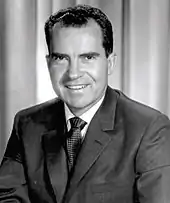| |||||||||||
| |||||||||||
Senator Richard M. Nixon's speech at a state Republican Party fundraiser in New York City on May 8, 1952, impressed Governor Thomas E. Dewey, who was an Eisenhower supporter and had formed a pro-Eisenhower delegation from New York to attend the national convention.[1] In a private meeting after the speech, Dewey suggested to Nixon that he would make a suitable vice presidential candidate on the ticket with Eisenhower.[2]
Nixon attended the convention as a delegate pledged to Earl Warren and represented California on the convention's platform committee.[3] In pre-convention remarks to reporters, Nixon touted Warren as the most prominent dark horse and suggested that if Warren was not the presidential nominee, Nixon's Senate colleague William Knowland would be a good choice for vice president.[4] As the convention proceedings continued, Warren became concerned that Nixon was working for Eisenhower while ostensibly pledged to Warren.[5] Warren asked Paul H. Davis of the Hoover Institution at Stanford University, who had been a vice president at Columbia University while Eisenhower was the school's president, to tell Eisenhower that Warren resented such actions and wanted them to stop.[3] Eisenhower informed Davis that he did not oppose Warren, because if Taft and Eisenhower deadlocked, then Warren would be his first choice for the nomination.[6] In the same conversation, Eisenhower indicated that if he won the nomination, Nixon would be his first choice for the vice presidency, because Eisenhower believed the party needed to promote leaders who were aggressive, capable, and young.[7] Eisenhower later developed a list of seven potential candidates, with Nixon's name at the top.[8]
After Eisenhower was nominated, his key supporters met to discuss vice presidential possibilities.[9] Eisenhower informed the group's chairman, Herbert Brownell Jr. that he did not wish to appear to dictate to the convention by formally sponsoring a single candidate, so the group reviewed several, including Taft, Everett Dirksen, and Alfred E. Driscoll, all of whom they quickly rejected.[9] Dewey then raised Nixon's name; the group quickly concurred.[10] Brownell checked with Eisenhower, who indicated his approval.[11] Brownell then called Nixon to inform him that he was Eisenhower's choice.[10] Nixon accepted, then departed for Eisenhower's hotel room to discuss the details of the campaign and Eisenhower's plans for his vice president if the ticket was successful in the general election.[11]
The delegates soon assembled to formalize the selection.[12] Nixon asked Knowland to nominate him, and Knowland agreed.[12] After Taft supporter John W. Bricker declined Nixon's request to second the nomination, Driscoll agreed to do so.[13] There were no other candidates, and Nixon was nominated by acclamation.[14]
Months after the convention, Eisenhower considered asking Nixon to step down as running mate due to controversy surrounding campaign expenses, but Nixon rallied public opinion with his Checkers speech and remained on the ticket.[15] The Eisenhower–Nixon ticket won the 1952 election, as well as the 1956 election, defeating the Stevenson–Sparkman and Stevenson–Kefauver tickets, respectively.
Potential running mates
Finalists
- California Senator Richard Nixon
- Massachusetts Senator & Co-Campaign Manager Henry Cabot Lodge Jr.[16]
- Minnesota Representative Walter Judd[17]
- Indiana Representative Charles A. Halleck[18]
- California Senator William F. Knowland[19]
- Colorado Governor Daniel Thornton[17]
- Washington Governor Arthur B. Langlie[20]
Others
- Illinois Senator Everett Dirksen[9]
- Ohio Senator Robert Taft[21]
- New Jersey Governor Alfred E. Driscoll[22]
See also
References
- ↑ Gellman, Irwin F. (2017). The Contender: Richard Nixon, the Congress Years, 1946-1952. New Haven, CT: Yale University Press. p. 418. ISBN 978-0-3002-2020-9.
- ↑ Gellman, pp. 418–419.
- 1 2 Gellman, p. 426.
- ↑ Gellman, p. 429.
- ↑ Gellman, p. 432.
- ↑ Gellman, p. 433.
- ↑ Gellman, p. 433-434.
- ↑ Ambrose, Stephen E. (1987). Nixon: The Education of a Politician 1913-1962. Vol. 1. New York, NY: Simon & Schuster. p. 262. ISBN 978-0-6716-5722-2.
- 1 2 3 Ambrose, p. 262.
- 1 2 Ambrose, pp. 262–263.
- 1 2 Ambrose, p. 263.
- 1 2 Ambrose, p. 264.
- ↑ Ambrose, pp. 264–265.
- ↑ Ambrose, p. 265.
- ↑ "VP Richard Nixon". US Senate. US Senate. Retrieved 7 October 2015.
- ↑ "The President and the Apprentice: Eisenhower and Nixon, 1952-1961". 22 March 2019.
- 1 2 Ambrose, p. 259.
- ↑ Gellman, p. 442.
- ↑ Ambrose, pp. 254, 260.
- ↑ Sigelman, Lee; Wahlbeck, Paul (December 1997). "The "Veepstakes": Strategic Choice in Presidential Running Mate Selection". The American Political Science Review. 91 (4): 858. doi:10.2307/2952169. JSTOR 2952169.
- ↑ Gellman, Irwin (2015-07-28). The President and the Apprentice: Eisenhower and Nixon, 1952-1961. Yale University Press. pp. 17–18. ISBN 9780300182255. Retrieved 7 October 2015.
- ↑ Bowen, Michael (2011). The Roots of Modern Conservatism: Dewey, Taft, and the Battle for the Soul of the Republican Party. Chapel Hill, NC: The University of North Carolina Press. p. 149. ISBN 9780807834855.
